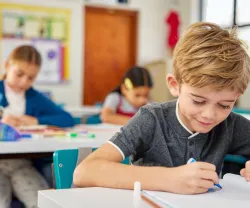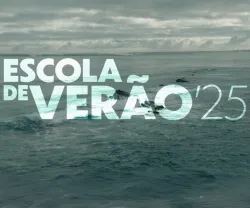
Teaching Creativity
Daisy Christodoulou, especialista inglesa em educação, fará a conferência de abertura do Mês da Educação 2018 «Escolas inovadoras, crianças criativas» juntamente com Rui Lima (cinco vezes vencedor do prémio Microsoft Innovative Educator Expert).
Creativity can be defined as the process of having original ideas that have value. I believe it is one of the highest aims we can have in education, and I also think creativity is something that we are all capable of: it isn’t something that is restricted to a special few.
However, there are many misguided ideas about the methods that will allow us to develop creativity in schools. Often, you will hear that creativity is innate within us all and all school has to do is to unleash it, or that we need to radically reinvent schooling to make it more child-centred and project-based, as this will help pupils to think in more creative and original ways. But the evidence shows this is not the case. Over the last hundred years, we have learnt more about how the mind works than ever before, and this research sheds light on how we can develop creativity. And this research shows that some of the apparently obvious methods of developing creativity will not work.
First, research shows us that to develop creativity, we need knowledge stored in our long term memories. When we think and solve problems, we can use working memory and long term memory. Working memory can be equated with consciousness: everything you are thinking about right now is happening in working memory. Long term memory consists of all the facts and knowledge you have stored away. Working memory is puny: it can hold only 4-7 new items of information at any one time. But long term memory is vast. We can store tens of thousands of facts in long term memory. As a result, most modern scientists accept that long-term memory is, in the phrase of one modern scientist, the seat of all human intellectual power and that without it humans would not be capable of the intellectual feats that as a species we are capable of – and those intellectual feats, of course, are often some of the peaks of human creativity.
The knowledge we have in long term memory is vital for creativity for a couple of reasons. First, creativity doesn’t happen in a vacuum. New and original ideas build on what has gone before: as Sir Isaac Newton, who didn’t lack creativity, said, ‘if I have seen further, it is by standing on the shoulders of giants’. We need knowledge of a particular field before we can create and innovate in it. Teachers know this, of course: the pupils who write the most original stories are paradoxically those who know the most stories themselves. Second, knowledge stored in long term memory frees up the precious and limited space in working memory so that we can respond at a more sophisticated level to the world around us. If we didn’t have knowledge of the phonetic code and vocabulary stored in long-term memory, we would never be able to appreciate the beauty of a poem, let alone write one, because we’d always be stuck sounding out the first words and wondering what they meant. By committing facts to long-term memory, we free up that precious and limited space in working memory to be able to combine ideas, to compare different facts, to apply our knowledge to a new problem or environment – in short, we free up the space in working memory to be creative. Thus, memorising facts doesn’t stifle creativity, it enables it.
Second, in order to be creative we need to practice. ‘Deliberate practice’ is a term coined by K Anders Ericcsson, one of the most prominent researchers in the field of expert studies. Ericsson’s work is the basis of much of Malcolm Gladwell’s popular idea about 10,000 hours of practice. The idea that practice makes perfect is hardly a new one, and we can all hopefully see why practice is such an important part of education. But whilst Gladwell popularised Ericsson’s research as being just about practice, actually, what Ericsson talks about is deliberate practice. Mere experience or hours logged doesn’t make you good at something. What matters are the types of activities you practice. And what Ericsson shows is that experts in all fields often practice in unlikely or unexpected ways. Musicians don’t actually practice their final concert piece over and over again in one go. Footballers don’t practice by playing full 11-aside matches over and over again. Instead, what these experts and their coaches do is to unpick the underlying skill and knowledge needed for such performances, and to practice that instead. So musicians practice scales, and footballers do passing exercises. And they do them over and over and over, until they have overlearned them and they are second nature. This kind of deliberate practice is vital in education too. In many cases, the constituent knowledge needed to become creative doesn’t look like the final end product. Often, it looks completely different. A lesson where pupils deliberately practice their times tables may not look like it is developing creativity, but it is. A lesson where pupils memorise poetry may not look like it is developing creativity, but it is. Developing creativity is counterintuitive. It isn’t always obvious.
By contrast, project-based lessons do not work as well. There is extensive evidence that such real world projects overload working memory and don’t allow for deliberate practice. Creativity is not developed directly in this way, and methods which may not look creative on the surface are actually extraordinarily effective at developing creativity.
A historical example will help illustrate this. Shakespeare, for example, is universally hailed as one of the greatest creative geniuses of all time. We know what his education looked like, and it did not involve projects. At Shakespeare’s school, pupils had to rote learn hundreds of Latin figures of speech. The knowledge was decomposed, decontextualized and utterly irrelevant to the life of a young glovemaker’s son in 16th century rural England. And just a few years after he left school, Shakespeare was using that knowledge in some of the most original and creative drama we’ve ever seen. Nor was this an accident - many academics have traced Shakespeare’s language directly from those schoolroom exercises in language, through to the early and sometimes clunky use of rhetorical devices in plays like Two Gentlemen of Verona, through to the brilliantly original and playful uses of such techniques in late plays like Hamlet and Julius Caesar. Nor was he an isolated example: the late 16th and early 17th century saw a flowering of such dramatic talent, with much of it produced by playwrights who had experienced the same Elizabethan grammar school education as Shakespeare.
When you look at creative geniuses in other fields and in other eras, you find something similar. Creative genius arises out of memorisation and practice. Like many great truths, this one is counterintuitive: innovation arises from tradition, and the methods of traditional schooling are the best hope we have of developing the creativity pupils need to face the challenges of the future.
Daisy Christodoulou é a oradora na Conferência de abertura do Mês da Educação 2018 «Escolas inovadoras, crianças criativas» (com transmissão em directo, dia 31 de Outubro às 16h30).
O acordo ortográfico utilizado neste artigo foi definido pelo autor.



![Imagem da dupla do [IN]Pertinente Sociedade, composta por Hugo van der Ding e Mónica Vieira](/sites/default/files/styles/teaser_small/public/2025-06/INP_SOCIEDADE_1280x720.png.webp?itok=roeftykF)